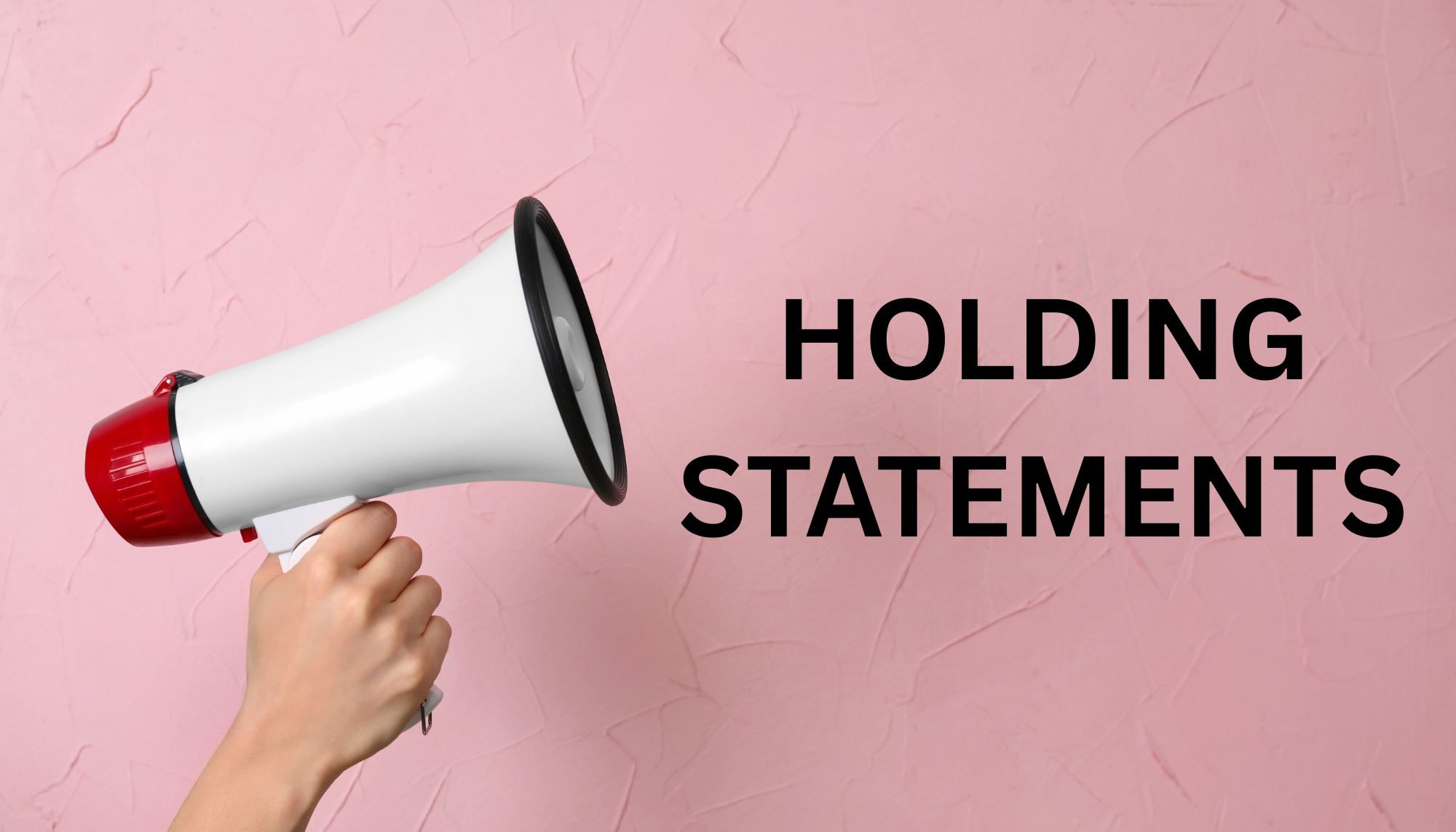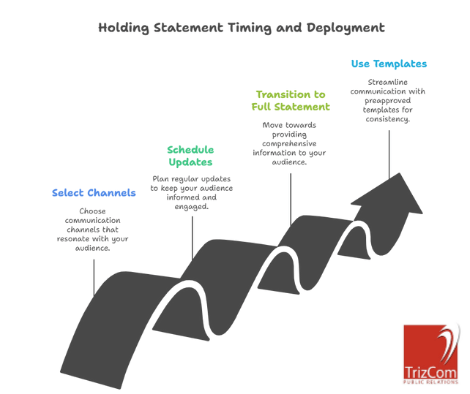Expect the Unexpected
Imagine your brand is about to celebrate a major milestone when social media erupts with reports of safety concerns. Within minutes, executives gather in a glass-walled boardroom while legal counsel reviews the first reports and customers refresh their feeds, hoping for news. In that moment, a holding statement becomes your bridge between uncertainty and confidence.
A holding statement is a brief message issued at the start of a crisis. It allows an organization to respond quickly while gathering facts. It assures internal and external audiences that your brand is aware of the situation. By sharing a concise update, stakeholders gain clarity and trust stays intact. Every organization benefits from a ready template that matches its brand voice.
In this guide, we explain the purpose of a holding statement and then explore its key components. Next, we cover how to craft one that feels genuine and aligns with values and finally, we offer tips to deploy it fast and avoid common mistakes. This approach reflects TrizCom PR’s clear caring communications that protect reputation.
Understanding the Purpose of a Holding Statement
A holding statement gives leaders time to confirm details without leaving audiences in the dark. In those first critical moments, every hour without an update can feed uncertainty. A well-timed message shows the organization is aware of the situation. It also reassures employees, customers, regulators and the media. That reassurance preserves goodwill. It can prevent rumors from spreading. Holding statements signal control and care. They set expectations for follow-up updates.
At TrizCom PR, we view this as a core component of crisis readiness. By establishing a reliable early response, we protect brand trust and reduce the risk of reputational harm. Clear honest messaging can turn a tense situation into proof of strong leadership.
Key Components Of An Effective Holding Statement
Acknowledgement
Briefly state awareness of the event. This shows you are listening and take it seriously.
Commitment to Action
Explain that you are gathering facts. Promise an update as soon as possible. This builds confidence in your process.
Empathy
Express genuine concern for anyone affected. A human touch reassures audiences that people matter more than PR.
Point of Contact
Offer a single spokesperson or channel for questions. This avoids confusion and ensures consistency.
Brand Voice
Use language that reflects your values. Maintain a professional and approachable tone that aligns with the organizational culture.
Each element plays a role. Acknowledgement stops silence. Commitment to action manages expectations. Empathy creates connection. A clear point of contact guides media and stakeholders. A brand voice ensures that every message feels authentic. Together, these parts form a template you can adapt to any scenario.
At TrizCom PR we work with clients to prewrite holding statements that satisfy legal requirements while still resonating on a human level. Having those templates reviewed in advance means brands can respond immediately with clarity and confidence when time is critical.
Crafting Your Preapproved Holding Statement
Begin with a clear concise opening sentence that names the situation. This demonstrates that you understand the urgency and sets a firm tone.
Use Active Solution Language
Choose verbs that emphasize action and control. Avoid using jargon that may confuse or distance your audience.
Keep It Short
Limit the statement to about 100 words. Brevity ensures it can be read and shared quickly.
Include One Data Detail
If you can confirm a fact, such as the number of sites affected or the timeline you have begun to review, share it. A concrete detail builds credibility.
Verify Legal and Factual Accuracy
Before release, run your draft through legal or compliance review. Correct facts avoid retractions later.
Align with Brand Values
Use phrases that reflect your organization’s voice. If you position yourselves as innovators, use forward-looking language. If you emphasize community use, use inclusive and empathetic wording.
These steps create a template you can adapt to any scenario. By drafting a preapproved holding statement, you save precious minutes in a crisis.
Timing And Deployment
Issue the first holding statement within the first hour of learning about an incident. Early acknowledgement prevents rumors from taking hold.
Select the Right Channels
Post on your website banner, send via press wire, share on social media and notify key stakeholders by email or text. Multiple touchpoints ensure no audience is left guessing.
Schedule Regular Updates
Plan to refresh your message every two to four hours as you gather new information. Even if there is no major change, a brief update reassures your audience that you remain engaged.
Transition to Full Statement
Once you confirm key facts, move from a holding statement to a detailed statement or full press release. That second message can address root causes, corrective steps and next actions.
Use Preapproved Templates
Maintain scenario-specific templates for data breaches, product recalls, workplace incidents and more. Having these ready lets you deploy messages without delay.
Timely clear deployment reinforces trust and demonstrates leadership under pressure.
Common Pitfalls And How To Avoid Them
Delayed Response
Waiting too long erodes confidence and gives space for speculation. Prepare templates in advance so you can issue messages immediately.
Vague Language
Ambiguous phrases frustrate audiences and fuel doubt. Include at least one solid fact to show you have begun to investigate.
Lack of Empathy
A sterile corporate tone feels uncaring. Add a sentence that acknowledges impact on individuals to convey genuine concern.
Inconsistent Messaging
Multiple voices or changing facts damage credibility. Centralize approvals with one spokesperson and use version control on all drafts.
Avoiding these common errors helps your holding statements support rather than hinder your crisis response. A simple, well-framed message can calm concerns and protect your reputation.
Real World Examples
A national food brand faced reports of contamination on social media. Within 45 minutes, it issued a holding statement acknowledging the claim and promising an urgent review. By sharing the number of stores under inspection and directing inquiries to a single hotline, it limited speculation and gained praise for transparency. In contrast, a tech company delayed its initial response by several hours and offered only vague reassurances. That silence allowed rumors to escalate and led to extra media scrutiny. The lesson is clear: rapid, clear messaging curbs uncertainty, while delays or ambiguity amplify risk.
Holding Statement Template
Internal Holding Statement Example
Date/Time Issued
Audience (e.g., all employees, specific team)
Situation
“We are aware of [brief description of incident].”
Empathy
“Our priority is the well-being of [employees/customers/partners].”
Next Steps
“We are gathering more information and will share updates by [timeframe].”
Spokesperson
“If you have questions, please contact [Name, Title, Email/Phone].”
Values Reminder
“We remain committed to [core value] as we address this situation.”
External Holding Statement Template
Date/Time Issued
Audience (e.g., media, public, clients/customers)
Acknowledgment
“We recognize that [brief description of incident] has occurred.”
Expression of Concern
“We regret any impact this may have on [stakeholders/customers].”
Commitment to Update
“We are investigating and will provide further information by [timeframe].”
Point of Contact
“For media inquiries, please reach [Name, Title, Email/Phone].”
Values Alignment
“We are guided by [core principle] in resolving this matter.”
Let’s assume your brand has a data breach. Here is what an internal holding statement and an external holding statement might look like:
Internal Holding Statement Example
July 23, 2025 9 AM CDT
We are aware of an unauthorized access incident that may have exposed customer and employee data within our systems. Our priority is the well-being of our employees and the customers who trust us with their information. We are gathering more information and will share updates by July 24 at 5:00 PM CDT. If you have questions, please contact Jane Doe, chief security officer, at jdoe@anycompany.com or (214) 555-5555. We remain committed to security and transparency as we address this situation.
External Holding Statement Example
July 23, 2025 9 AM CDT
We recognize that an unauthorized access incident has occurred that may have exposed personal and account information. We regret any impact this may have on our customers and partners. We are investigating and will provide further information by July 24 at 5:00 PM CDT. We remain committed to security and transparency as we address this situation.
For media inquiries, please contact John Doe, director of public relations, john.doe@anycompany.com (214) 555-5555.
Integrating Holding Statements Into Your Crisis Plan
Start by drafting templates for likely scenarios such as supply chain issues, data breaches and safety incidents. Involve legal, operations and communications teams in regular reviews to keep details accurate. Schedule quarterly tabletop exercises to practice issuing and updating statements under time pressure. Store approved templates in a shared secure folder so the crisis team can access them at once. Align holding statement triggers with your broader crisis response workflow, ensuring seamless handoff from initial alert to full incident report. This preparation lets your organization move from uncertainty to action without delay.
Safeguarding Your Reputation Going Forward
Holding statements serve as your first line of defense in a crisis. They buy crucial time, maintain stakeholder trust and lay the groundwork for a detailed response. By crafting clear concise messages in advance and integrating them into regular drills you ensure your team can act with confidence.
Partner with TrizCom PR
TrizCom PR can help you develop a tailored playbook and run live drills and scenarios that give your team the clarity and confidence to respond fast and sincerely. Connect with our experts or call us at 214-242-9282 to discover how to maintain control over your brand when the unexpected arises.
Integrating Holding Statements Into Your Crisis Plan
Start by drafting templates for likely scenarios such as supply chain issues, data breaches and safety incidents. Involve legal, operations and communications teams in regular reviews to keep details accurate. Schedule quarterly tabletop exercises to practice issuing and updating statements under time pressure. Store approved templates in a shared secure folder so the crisis team can access them at once. Align holding statement triggers with your broader crisis response workflow, ensuring seamless handoff from initial alert to full incident report. This preparation lets your organization move from uncertainty to action without delay.
Safeguarding Your Reputation Going Forward
Holding statements serve as your first line of defense in a crisis. They buy crucial time, maintain stakeholder trust and lay the groundwork for a detailed response. By crafting clear concise messages in advance and integrating them into regular drills you ensure your team can act with confidence.
Partner with TrizCom PR
TrizCom PR can help you develop a tailored playbook and run live drills and scenarios that give your team the clarity and confidence to respond fast and sincerely. Connect with our experts or call us at 214-242-9282 to discover how to maintain control over your brand when the unexpected arises.






